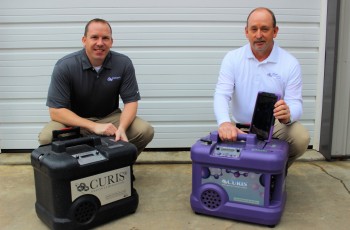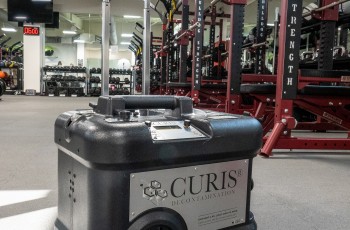
Chuck Peeples and his team at Midwest Pathogend Services utilizes multiple methods to bring about the best outcome in disinfecting and decontamination, beginning with the CURIS Decontamination System foggers.
With the coronavirus in the news and making headlines in recent weeks, the public is reminded more than ever of the presence of microorganisms, viruses, and bacteria, which can lead to dangerous – even deadly – outbreaks.
Despite the best conventional cleaning products and techniques, oftentimes, neither are a match for the myriad of various sickness-causing microorganisms that hide all around us. To ensure the most thorough disinfecting possible, sometimes, it’s necessary to call in the professionals – professionals like Midwest Pathogend Services.
Midwest Pathogend Services is a certified provider of the Pathogend® Services network, offering whole-space disinfection services and decontamination products tailored to meet the most stringent needs of their clients through a combination of techniques to disinfect spaces, from manually wiping surfaces with a high-grade disinfectant and fogging rooms with a proprietary hydrogen peroxide fog.
Midwest Pathogend – so named as their goal is to “end the path to infection” – servicing greater Northeast Oklahoma and surrounding areas.
“I spent the last 20 years in the healthcare industry and Life Sciences area and did some government contracting,” said Chris Schultheis, owner, Midwest Pathogend Services. “My wife was a teacher for several years and recently became a registered nurse in pediatrics and is usually exposed to a lot of germs, viruses, etc. and because of this she can be sick a couple times a year and realizes the importance of proper disinfection techniques.”

Chris Schultheis and Chuck Peeples display two of the CURIS system units used to disinfect and decontaminate homes, offices, schools, nursing homes, churches, and more.
“About two years ago, I learned about a newly developed technology that was designed by a Florida microbiologist after her daughter contracted an MRSA infection,” he continued. “This technology, combined with a product we use called CURoxide – which is a seven percent Hydrogen Peroxide fogging formula – enable us to offer our customers the most comprehensive decontamination possible.”
After researching the technology, making several trips to Florida to visit with the founder and her team of specialists, Schultheis decided to purchase equipment to start his own Pathogend Services company in Oklahoma.
“In addition to the decontamination service, one thing we do a lot of right now – especially since we’re still relatively new, as far as companies go, is to educate the public about who we are, what it is we do, and why what we do is so important,” he said. “One misconception people tend to have about us in the beginning, is that we’re a cleaning company or a janitorial company, but that’s not us – we’re a multi-faceted high-end decontamination service.”
Partnering with veteran GRDA employee, Chuck Peeples, the pair set about connecting with the public and potential customers, quickly becoming the decontamination service professionals for Inola Public Schools, partnering with large Oklahoma businesses, and others.
Midwest Pathogend Services utilizes multiple methods to bring about the best outcome in disinfecting and decontamination, beginning with the CURIS Decontamination System foggers.
“The CURIS foggers are a portable fogging system capable of disinfecting a room or enclosed area via a pulse technology,” Schultheis said. “While other systems rely on dispensing chemicals and turning off once the desired time is achieved, or depend on manual spraying, this system goes a step further by focusing on a ‘maintained pathogen-kill zone.’ The process maintains that volume of solution within a space to improve optimal environmental conditions.”
Additionally, the CURIS system employed by Midwest was designed to reduce human error, allowing Schultheis or Peeples to monitor, manage, track, and report the decontamination process.
“The system uses .08 ounces (of solution) per cubic feet of space being decontaminated and calculates how much time will be needed to fill every inch of that room with the solution,” Peeples said. “This is important because a common misconception to disinfecting is that you wipe a surface, say, with a disinfectant, and wipe it off, but some of the harder to kill germs or viruses require you to leave a disinfectant on a surface for up to 10-20 minutes, and our process fills every cubic inch of a space for the time needed to kill germs, bacteria, etc.
“The (CURIS) system will update us on its progress when the work is done, and if it’s a job that requires more than one unit, should one (unit) stop production, it communicates with the other units, which then ‘pick up the slack’ and increase their solution output to compensate,” he said. “We’re alerted to all of this through electronic notifications, so we’re able to closely monitor the entire process.”
Midwest’s highly-effective CURoxide solution may be sprayed directly onto surfaces or used in a fog to saturate an area. The fog itself is non-corrosive, odorless, leaves no residue, and can safely provide full-room decontamination for offices, schools, gymnasiums, nursing homes, hotels, homes, or other spaces.
As varied as pathogens are, Schultheis said that the decontamination services he provides for what the medical industry calls a 6 log kill or 99.9999% on bacteria, viruses, fungi or other pathogen in a room or space.
“One of the biggest and hardest to kill pathogens is C. diff or Clostridium difficile – which is a tough little bacteria that causes a more severe form of antibiotic-associated diarrhea – the bacteria causes mild diarrhea to severe colon inflammation, which can even be fatal,” Schultheis said. “C. diff is a spore, and to be able to kill that isn’t easy, but our technology and products work together as an effective sporicide, as well as killing viruses, bacteria, and other germs.”
C. diff is found in fecal matter and spread by touching a contaminated surface, such as a keyboard, blanket, or doorknob, often common in nursing homes, daycares, public restrooms, or anywhere else proper hygiene may be difficult or challenging.
“On the scale of ‘kill difficulty,’ viruses are actually the easiest (to kill), even the coronavirus and Ebola, for that matter,” said Chuck Peeples, operations manager, Midwest Pathogend Services. “At the bottom are viruses that have lipid envelopes – those ‘envelopes’ usually being derived from portions of the host’s cell membranes, but also include glycoproteins, and help (the virus) to evade the host’s immune system. Examples of these would be the flu, HBV, measles, mumps, rubella, chickenpox, Zika, and others.”
Above these are gram-positive bacteria such as staphylococcus and streptococcus. Above these are gram-negative bacteria, such as pseudomonas, Acinetobacter, Klebsiella, E. coli, and legionella.
“Harder to kill than the bacteria are fungi, including fungal spores, like Aspergillus fumigatus, A. flavus, Candida Auris, and above them are viruses without envelopes – Norovirus, Rotavirus, Rhinovirus, HPV, and others, and harder than these are myobacteria – Tuberculosis, and Mycobacterium Avium,” he said.
At the top of this “kill difficulty” pyramid are bacterial spores, such as tetanus, botulinum, Anthrax, and the aforementioned clostridium difficile, which is rated a “very high level” needed for disinfection. But despite the high difficulty level of the various spores, mold, bacteria, and viruses, the solution utilized by Midwest Pathogend has an astounding 99.9999% kill rate.
As to areas he would most like to grow his business, Schultheis felt Midwest would particularly help school systems.
“We’re in Inola (schools), but we would like to get into other schools,” Schultheis said. “It’s sad that we have to shut down entire school systems because of the flu. It’s hard for janitorial staff to wipe everything down. We could easily be used as an adjunct to that, basically bringing our state-of-the-art technology in and take care of it in a couple of hours. Right now, we’re really concentrating on trying to help the schools – we’ve not only helped Inola but Lincoln-Christian and the school at Church on the Move, where I go to church.”
So, whether you’re fighting an outbreak or wanting to prevent your building or facility from becoming a breeding ground for infection, trust the training, experience, and tools of Midwest Pathogend Services, and rest assured that no germ will be left behind. For more information, contact Midwest Pathogend Services at 888-505-7032 or email eat0@eau0eav0eaw0

The girls weight room and other facilities at Lincoln Christian School are regularly disinfected to prevent irregular contamination.
See More about Midwest Pathogend Services: Leaders in Whole Space Biological Decontamination:

